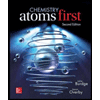
Concept explainers
Interpretation: The valid resonance structure for
Concept introduction: Sometimes the
In some molecules, there is possibility of more than one Lewis structure where all the structures are equally acceptable. One of the acceptable Lewis structures of these molecules is called resonance structure.
All the possible resonance structures are imaginary whereas the resonance hybrid is real.
Any of the possible structure does not exist as such like a stable real molecule. So it is not possible to isolate one resonance structure.
These structures will differ only in the arrangement of the electrons not in the relative position of the atomic nuclei.
Structure with greater number of covalent bonds are more stable comparing to that with lower number of covalent bonds.
Structure which does not involve charge separation is more stable when comparing with structure having positive and negative charge separation.
While drawing resonance structure of a molecule some rules should be followed where the position, over whole charge and chemical framework remains intact. Also only π and nonbonding electron has been moved in all the three resonance structures
Want to see the full answer?
Check out a sample textbook solution
Chapter 6 Solutions
Chemistry: Atoms First
- Follow the Instructions to build the following ion that will satisfy octet rule : [NO2]- Hint: use O-N-O order the atoms, with one single and one double bonds. How many lone pairs of electrons in this structure?arrow_forwardSelect all molecules that are expected to be polar.arrow_forwardDetermine the number of resonance structures frot the follwoing molecule, include the original sturcture in the tally.arrow_forward
